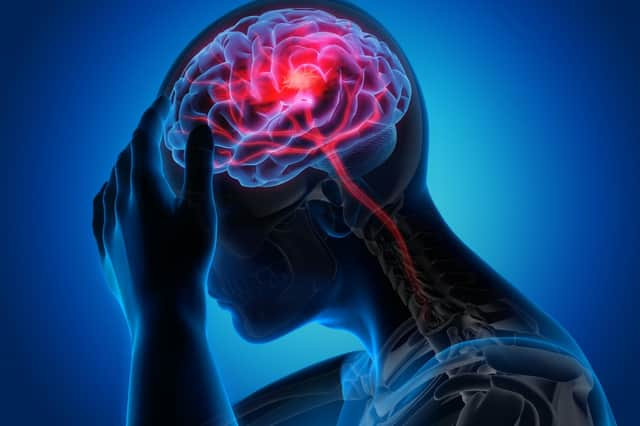How to lower your stroke risk at every age


“A stroke is when blood supply to the brain is blocked or reduced,” explains Dr Angela Rai, GP at The London General Practice.
“There are two main types of stroke. An ischaemic stroke, when blood flow is blocked to the brain [usually due to a clot] and the brain does not get enough oxygen and cells die, and haemorrhagic stroke, when there is a bleed in the brain. Most strokes tend to be ischaemic and are associated with certain risk factors,” Rai adds.
Can you prevent strokes?
Advertisement
Hide AdAdvertisement
Hide Ad

As the NHS website states, it isn’t always possible to prevent a stroke, as some risk factors are unchangeable. This includes age – most strokes happen in people in their 60s and 70s, although anyone can potentially be affected – as well as genetics, family history, and ethnicity (stroke risk is generally higher in south Asian, African or Caribbean communities). Having certain other health conditions may also be linked with stroke.
However, statistically speaking, there are things we can do to help reduce the risk, especially when it comes to preventing and managing high blood pressure, type 2 diabetes and high cholesterol, which are all key risk factors.
With this in mind, here’s how to lower your stroke risk at every age…
In your 20s and 30s
Research suggests lifestyle habits earlier on may help protect cardiovascular health in later life.
Advertisement
Hide AdAdvertisement
Hide Ad“Although stroke is extremely uncommon in our 20s and 30s, it is important to have a healthy lifestyle to reduce risks of developing high blood pressure or high cholesterol later on in life,” says Dr Rai. “High blood pressure is a major risk factor for stroke. Maintaining a healthy lifestyle can keep your blood pressure under control and therefore reduce the risk.”
Creating healthy lifestyle habits doesn’t have to mean going to extremes, however. Dr Rai suggests: “Eating healthy – having a diet lower in sodium, fat and sugar can reduce the risks of high blood pressure, high cholesterol and diabetes. Regular exercise, drinking alcohol sensibly within the recommended guidelines, and not smoking.”
Being mindful of salt intake is particularly important when it comes to stroke – so keep an eye on processed and ready-made foods and takeaways, as these often contain lots of ‘hidden’ salt.
As professor Graham MacGregor, chairman of Action on Salt and Blood Pressure UK, says: “Half of all strokes and heart disease are due to high blood pressure, which can easily be reduced, particularly by reducing your salt intake, doing more exercise, eating more fruit and vegetables and, if necessary, taking tablets which have very few side-effects.
Advertisement
Hide AdAdvertisement
Hide Ad“As a nation, if we cut one gram of salt from our average daily salt intake there would be approximately 6,000 fewer deaths from strokes and heart attacks each year in the UK.”
In your 40s and 50s
Those healthy habits recommended in your 20s and 30s? They’re still important as you enter midlife. However, there may also be some additional considerations.
“Later on in our 40s and 50s, it becomes more important to see your GP to have your blood pressure checked,” says Dr Rai (you can also get it checked for free in pharmacies).
“High blood pressure may not have any symptoms and may go unnoticed for many years, by which time some damage is already done.
Advertisement
Hide AdAdvertisement
Hide Ad“Having blood tests, such as cholesterol levels and glucose check for diabetes can help manage risk factors. There are several other blood markers which are useful for assessing cardiovascular risk,” she adds.
“Maintaining a healthy weight is also vital, as obesity is a risk factor for all cardiovascular disease, including stroke. And following the guidance of your medical practitioner, including lifestyle changes and taking medication to reduce blood pressure or cholesterol if required.”
Keeping stress levels in check may become increasingly important during this life chapter too – especially if working long hours, juggling caring responsibilities and financial pressures.
Dr Rai adds: “Staying active and reducing stress are important throughout life, but during these decades are even more important when you have a busy lifestyle.” So, make self-care and time to switch off and recharge part of your priorities list.
In your 60s and beyond
Advertisement
Hide AdAdvertisement
Hide AdOne of the key things as we enter our 60s, 70s and 80s is making sure any co-existing health issues are being well managed.
“Another important risk factor for stroke is atrial fibrillation (AF). This is a rapid, irregular heartbeat which is usually diagnosed after the age of 60, but can affect anyone at any age,” says Dr Rai.
“AF occurs due to an ageing cardiovascular system and the risk factors associated with poor cardiovascular health. The chambers of the heart do not pump efficiently and there is a risk of blood clots forming. If these clots travel into the general circulation, there is a risk of stroke.
“AF increases the risk of stroke by around five times, therefore it is important if you have any symptoms – such as a palpitations, dizziness or chest pain – you should seek medical attention. However, many people do not have any symptoms and it may only be picked up on routine examination. Treatment includes medication to reduce the risk of clots, as well as medication to control the heart rate.”
Comment Guidelines
National World encourages reader discussion on our stories. User feedback, insights and back-and-forth exchanges add a rich layer of context to reporting. Please review our Community Guidelines before commenting.